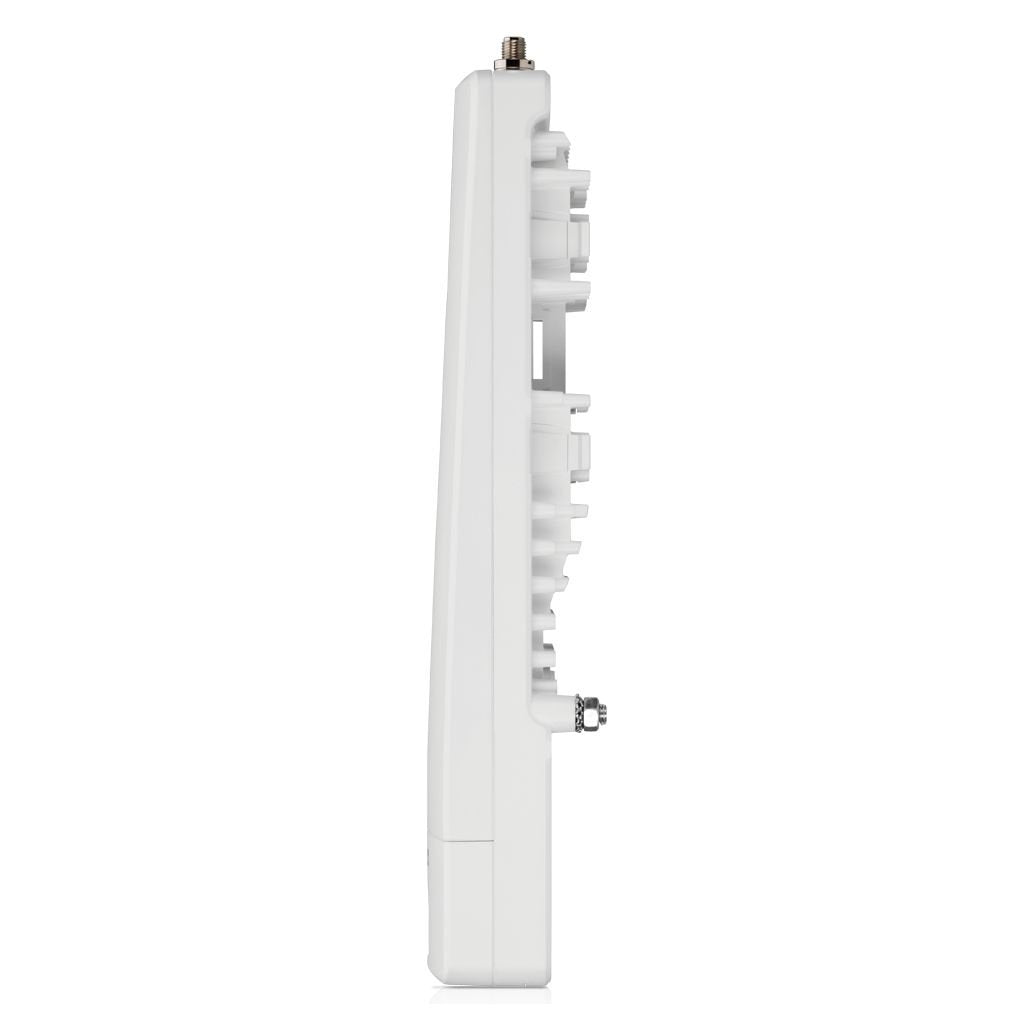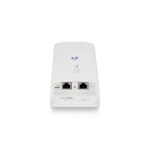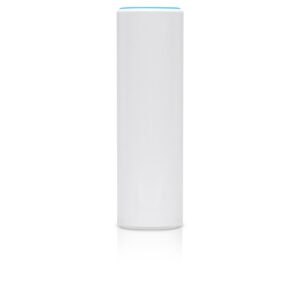Ubiquiti LTU-ROCKET Outdoor 5GHz Point-to-Multi-Point PtMP Link BaseStation 675.84 Mbit/s White
- Description
- Specifications
-
Ubiquiti LTU-ROCKET Outdoor 5GHz Point-to-Multi-Point PtMP Link BaseStation 675.84 Mbit/s White
The Ubiquiti LTU Rocket Outdoor Point-to-Point BaseStation is the first Point-to-Multi-Point (PtMP) BaseStation radio in the LTU product family. Operating in the 5 GHz frequency band, the LTU Rocket is a spectrally efficient, noise-resilient PtMP AP specifically designed for wireless ISPs (WISPs).
Key Features
600+ Mbps PtMP performance (1+ Gbps with future firmware upgrade).
Up to sixty-four (64) client connections per AP.
2+ Million pps.
Proprietary RF filtering.
Integrated GPS for improved synchronisation.
10/20/30/40/50/100 MHz Channel Width Flexibility.
By default, the Auto Output Power option allows the LTU Rocket to set the output power (EIRP) to the appropriate level.
Can use different frequencies for TX and RX to avoid interference.Superior performance
LTU is a new, proprietary technology with custom silicon and radio design that break through the limitations of 802.11 WiFi technology. This enables the LTU Rocket to deliver far superior performance over previous airMAX products that are based on 802.11 WiFi. The LTU Rocket is designed for WISPs from the ground floor up. Its core communications processing engine enables low latency, long-range capability, DFS flexibility, higher constellations, better power output, and improved receive sensitivity.Seamless compatibility
The LTU Rocket is designed to be paired with a variety of Ubiquiti antennas to suit the needs of each installation. The radio includes a mounting bracket that allows it to be used with a 5 GHz airMAX Sector antenna or airMAX Omni antenna (see accessories tab) for a complete 5 GHz PtMP BaseStation. You can even pair three LTU Rocket radios with the airPrism 5 GHz 3×30° HD Sector Antenna (see accessories tab) for co-location deployments. The LTU Rocket also works with any CPE device in the LTU family, such as the LTU Pro (see accessories tab).Channel width flexibility
Channel width flexibility allows independent TX and RX channel frequency configurations anywhere within the radio band to avoid local interference. Channel width options include the following
10 MHz
20 MHz
30 MHz
40 MHz
50 MHz
Up to 100 MHzSignal control
The LTU Rocket’s target TX output power controls each station’s TX output power. A PtMP network can manage signal levels to enhance network stability and achieve optimal wireless performance with the highest possible modulation.Convenient configuration
To manage the LTU Rocket, you have two options: the LTU Configuration Interface, and Ubiquiti Network Management System (UNMS). Either option lets you manually configure the LTU Rocket. The LTU Rocket can also be used to automatically configure the stations. On each station, use the Find My AP feature to scan for APs using the same channel bandwidth, select the appropriate LTU Rocket, and then use it to configure the station.Integrated GPS
Built-in GPS improves synchronisation and allows map and Fresnel views on the Dashboard.PtMP Dashboard
The Dashboard offers map and Fresnel views so you can visualise the network. The map view shows your PtMP links overlaid on a geographic map, while the Fresnel view shows the link calculated for your selected CPE, including line of sight, first Fresnel zone, and 60% clearance zone.New graphs provide instant status updates and help you to detect connectivity issues and their effects on PtMP performance
The airtime distribution bar graph displays in real time how much airtime each CPE is using. Click any point to view the airtime and link score for a specific CPE.
The AP RF environment bar graph shows ambient RF noise levels across the frequency spectrum.
The combined remote RF environment bar graph also shows ambient RF noise levels but for the combined environment of all of the remote CPEs.
The local and remote RX rate histograms show the receive modulation rates of the various CPEs.Real-time spectral analysis
airView spectral analysis runs on a dedicated and independent receiver, which has excellent EVM (Error Vector Magnitude) performance. The receiver can also perform other tasks, such as a search for channel occupancy, DFS detection, and automatic channel/ frequency assignment. Calibration (signal level measurement accuracy) and resolution bandwidth options are enhanced. Spectral zoom (user-defined scan limits) is also available.Deployment flexibility
The LTU Rocket can be used with existing airMAX 5 GHz sector antennas (see accessories tab) offering gain of 16 to 22 dBi, as well as airMAX 5 GHz omni antennas (see accessories tab) offering gain of 10 to 13 dBi. The radio’s built-in mounting bracket allows it to fit into the radio mount of these antennas – no special tools are needed for installation. -
Feature Specification Mechanical Dimensions 224 x 82 x 48mm (8.8 x 3.2 x 1.9″) Weight 468 g (1 lb) Enclosure material Diecast aluminum, polycarbonate Mount material Metal, polycarbonate Mounting Integrated pole mount (Kit included) GPS pole mount (Kit included) Rocket mount compatible Weatherproofing IP67 Hardware Networking interface (2) GbE RJ45 ports Power method Passive PoE 4-pairs (1, 2+; 3, 6-) (4, 5+; 7, 😎 Passive PoE 2-pairs (4, 5+; 7, 😎 or (1, 2+; 3, 6-) Power supply 24V, 1A gigabit PoE adapter (Included) Supported voltage range 18—54V DC Max. power consumption 24W RF connections (2) RP-SMA weatherproof (CH0, CH1) (1) SMA weatherproof (GPS) GPS Yes GPS antenna External magnetic base Button Factory reset Ambient operating temperature -40° to 55° C (-40° to 131° F) Certifications FCC Software Mode PtMP BaseStation radio Services SNMP, SSH, dynamic DNS, webserver, remote log, ping… Utilities airView®, speed test, alignment, discovery, ping, t… Auto distance adjustment Yes Auto power adjustment Yes Security Yes Statical reporting Yes Management interface Bluetooth management for easy setup over UISP App WEB UI Minimum software requirements Any modern web browser… iOS™ or Android™ based smartphone System Maximum throughput 900+ Mbps* Packets per second 2+ million Supported clients count 100+ Maximum range 100+ km* Encryption WPA2-PSK (AES) Uplink/Downlink ratio 25/75, 33/67, 50/50 RF Operating frequency US/CA U-NII-1 U-NII-2A U-NII-2C U-NII-3 Worldwide 5150 – 5250 MHz 5250 – 5350 MHz 5470 – 5725 MHz 5725 – 5850 MHz 4800 – 6200 MHz Max. conducted TX power 29 dBm Channel bandwidth 10/20/30/40/50/60/80/100 MHz* selectable Programmable uplink and downlink duty cycles Management radio 2400 – 2483.5 MHz



























